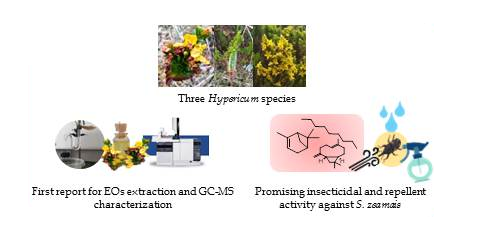JOURNAL 1665
Records of Natural Products
Year: 2021 Issue: 2 March-April
p.111 - 121
Viewed 2376 times.
-
William Ramiro Patiño Bayona

-
Erika Plazas

-
Jenifer Jhoana Bustos Cortes

-
Juliet Angélica Prieto Rodríguez

-
Oscar Javier Patiño Ladino

GRAPHICAL ABSTRACT

ABSTRACT
The maize weevil (Sitophilus zeamais) is one of the main insect responsible of significant losses in stored products, and to keep nutritional value of them to find effective and safe solutions are very important. The Hypericum genus might be a potential source of new bio-insecticides due to the chemical composition of essential oils. In this study, components of essential oils of three Hypericum species were investigated for first time by Gas Chromatography-Mass Spectrometry (GC-MS) and, fumigant and contact toxicities as well as the repellent activity of essential oils of them were evaluated against S. zeamais adults. While the main components in H. mexicanum oil were determined as n-nonane (53.08%) and α-pinene (25.28%), the major constituents were determined as α-pinene (45.52%) and β-caryophyllene (13.59%) in the essential oil of H. myricariifolium. Chemical composition of essential oil of H. juniperinum were found to be n-nonane (12.0%), α-pinene (8.25%), geranyl acetate (7.93%), and β-caryophyllene (13.60%). The results revealed that H. mexicanum and H. myricariifolium oils have fumigant toxicity (LC50 < 500 µL/L air) and a potential action as repellents (RP > 70% at 6.2–22.7 μL/L air) for the control of the pest.
KEYWORDS- Sitophilus zeamais
- essential oil
- repellent
- Hypericum mexicanum
- Hypericum myricariifolium
- Hypericum juniperinum